Message Catalog
Overview
The Message Catalog allows Admins to define reusable Messages that can be leveraged across multiple areas of the Quiq product, including all areas that Snippets can be selected, and in Proactive AI, Conversation Rules, and Bots. This allows you and your team to share commonly used Messages quickly and easily, saving time and eliminating typographical errors.
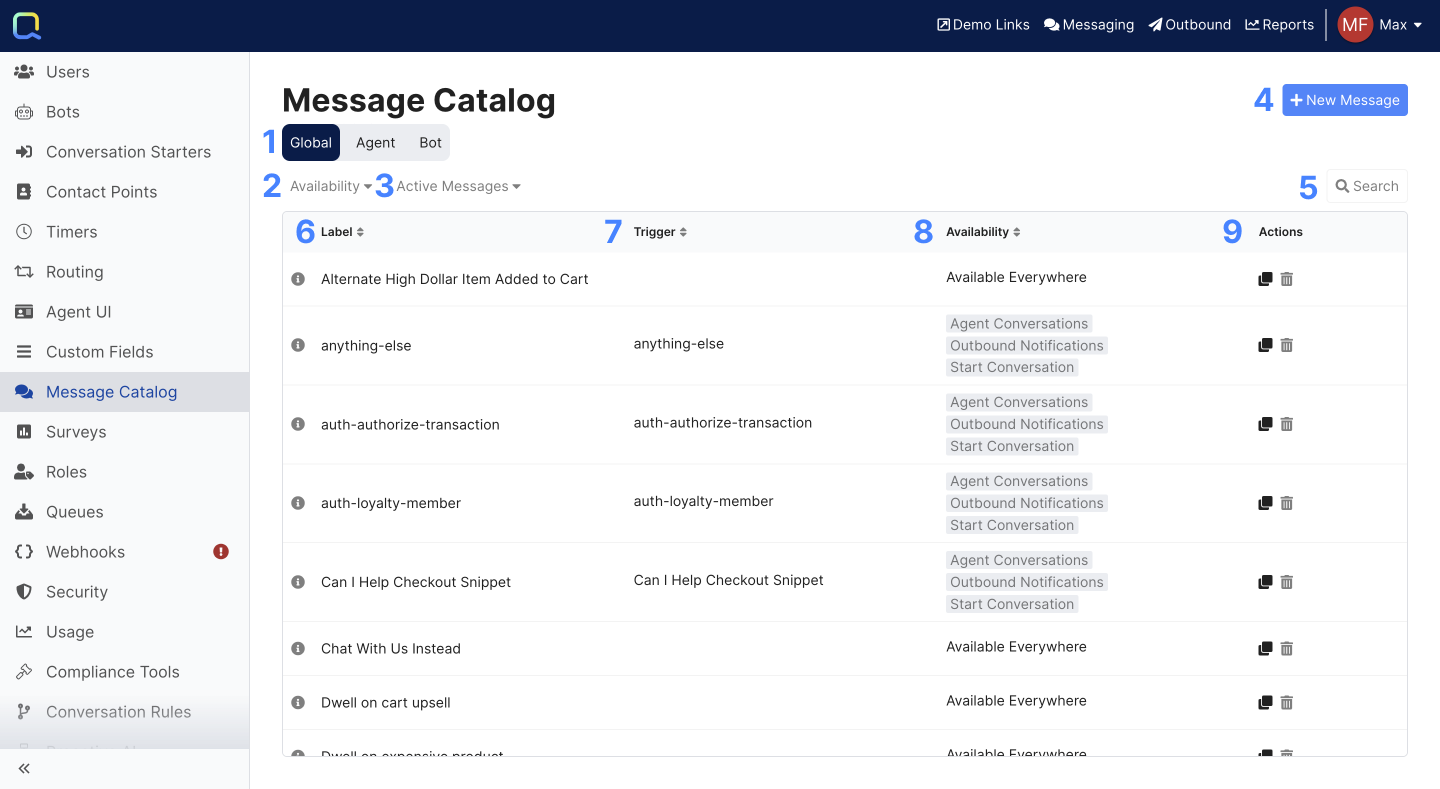
1. Enables Admins to toggle which Messages will display based on which option is selected. The Agent & Bot views will display Messages owned by individual agents and Bots. Depending on which option is selected, the columns in the table will change.
2. Use the Availability dropdown to filter Messages based on where they can be used.
3. Use the Active Messages dropdown to toggle between active and disabled Messages.
4 Use the New Message button to create a new Message.
5. Search for a particular Message by its Label, Trigger or ID.
6. The Message Label, this is how the Message is referenced internally within Quiq.
7. The Message Trigger that agents can use to quickly select a Snippet to send.
8. Where the Message can be used.
9. Enables Admins to duplicate or disable a particular Message.
All Snippets in your Quiq site, both those available for everyone & those owned by individual agents, automatically have corresponding Catalog Messages. This allows Admins the ability to easily view, create and modify all Snippets in your Quiq site from the Message Catalog.
The Snippets set to be available for everyone will be listed in the Global view, and those owned by individual agents will be listed in the Agent view.
Going forward, Snippets set to be available for everyone can still be viewed from the Snippets editor, but they can only be created and modified by Admins from the Message Catalog editor. Agents can still view, create & update their individually-owned Snippets from the Snippets editor.
Creating a Catalog Message
There are a number of options when creating a new Catalog Message that impact where a Message can be used, and what functionality it has.
Message Elements
Catalog Messages can consist of just text, or they can contain a variety of rich messaging elements:
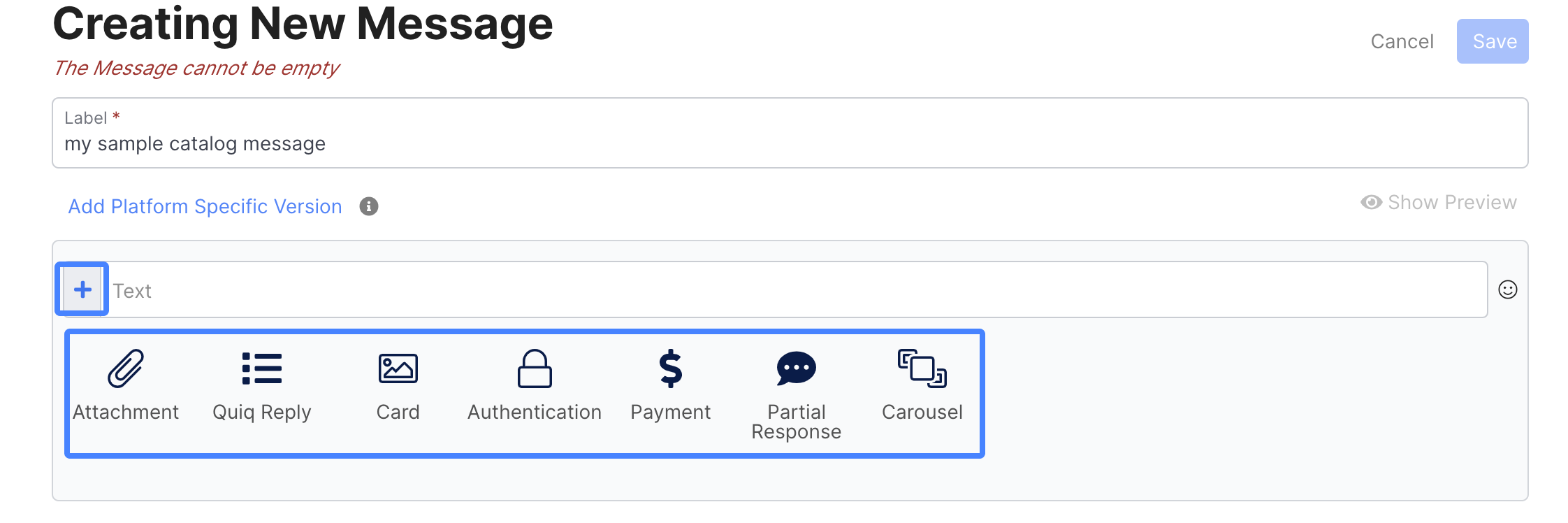
Attachment
Adds an attachment to the Message, refer to Supported MIME Types for File Attachments for a list of supported assets.

Quiq Reply
Add a list of selectable responses that may be presented to and easily selected by a user. In most cases this is presented as a question or instruction to make a selection. The question or instruction is entered in the text field, then replies may be added below by clicking the + Add Reply button:

A number of advanced options can be added to a Quiq Reply by using the 3 dot menu on each Quiq Reply:

- Custom prefix: Allows you to specify the single character prefix that displays for each reply item in a Quiq Reply for SMS end users (all other platforms display buttons for each reply). For example, you could set the prefixes for a Quiq Reply to be 1), 2), 3) instead of a), b), c).
- Add Aliases: Allows you to define other words for a reply item that when sent as a response by end users will also match that reply. For example, you could define the aliases 'Yes' & 'Yep' for a reply item with the label 'Yes', so if an SMS end user actually types and sends either of those words instead of sending the 'Yes' reply's prefix, that reply item would still be matched.
- Change status: Allows you to define what should happen to the conversation status when that Quiq Reply is selected.
- Route to queue: Allows you to route to a specific Queue when a Quiq Reply is selected
- Change field value: Allows you to set or change a field value. Standard, editable customer fields as well as custom conversation or customer fields may be set.
- Dismissal Reply: Enables the Quiq Reply to not start a new conversation if one is not currently active.
Card
Authentication
You can use an Authentication type Message to verify your customer's identity as needed. In order to use this feature, your Quiq site must be enabled. See End User OAuth for more information. Note that Authentication Messages aren't supported in Proactive AI message blurbs.

Payment
Use a Payment type Message to easily request payment for your product or services. The payment request will be sent via messaging to your customer sending them to your payment provider. Learn more about Quiq's Custom Pay Framework.
In order to add a Payment type Message, your Quiq site must be setup with Quiq Pay Integration. Contact Quiq to enable this.
Note that Payment Messages aren't supported in Proactive AI message blurbs.

Partial Response
The Partial Response type is used to send a message to a customer when they are not expected to reply. The Adaptive Response Timer will be in effect when the message is sent and the response timer will remain active until the agent sends another message. Note that Partial Response Messages aren't supported in Proactive AI message blurbs, or in Conversation Rules & Bot Messages.

Carousel
A Carousel consists of Cards that can contain an image, Title, Subtitle, and URL, as well as some additional advanced configuration such as buttons. Carousels can be configured either vertically or horizontally. In order to use this feature, please contact Quiq to enable it in your site.
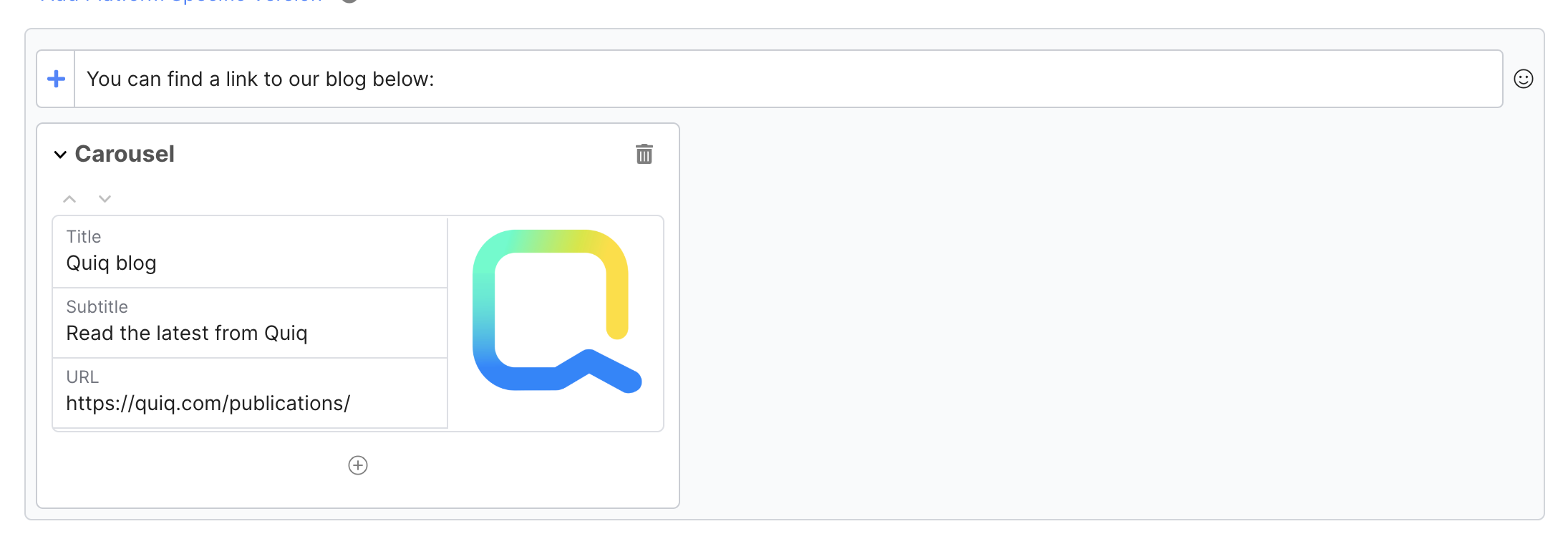
Availability
There are four Availability options for a Message when in the Message Catalog editor in the Admin console:

Available everywhere
When Available everywhere is selected, the Message will be able to be used in Agent Conversations, Conversation Rules, Outbound Notifications, Proactive AI, Bots & the Start Conversation dialog.
When creating a Message that is available everywhere, a Trigger must be defined for use in Agent Conversations, Outbound Notifications, and Start Conversation:

A sample trigger.
Available in specific areas
When Available in specific areas is selected, a checkbox displays that enables an Admin to select where this particular Message can be used:
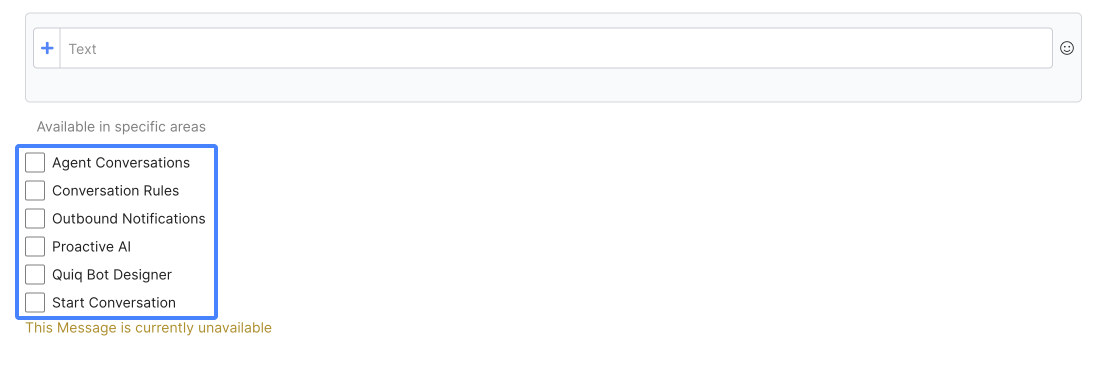
If Agent Conversations, Outbound Notifications, or Start Conversation are selected, a required Trigger field will display.
Available for specific agent
When Available for specific agent is selected, you'll need to define both the Trigger for the Message, as well as select the individual Agent who has access to this Message.
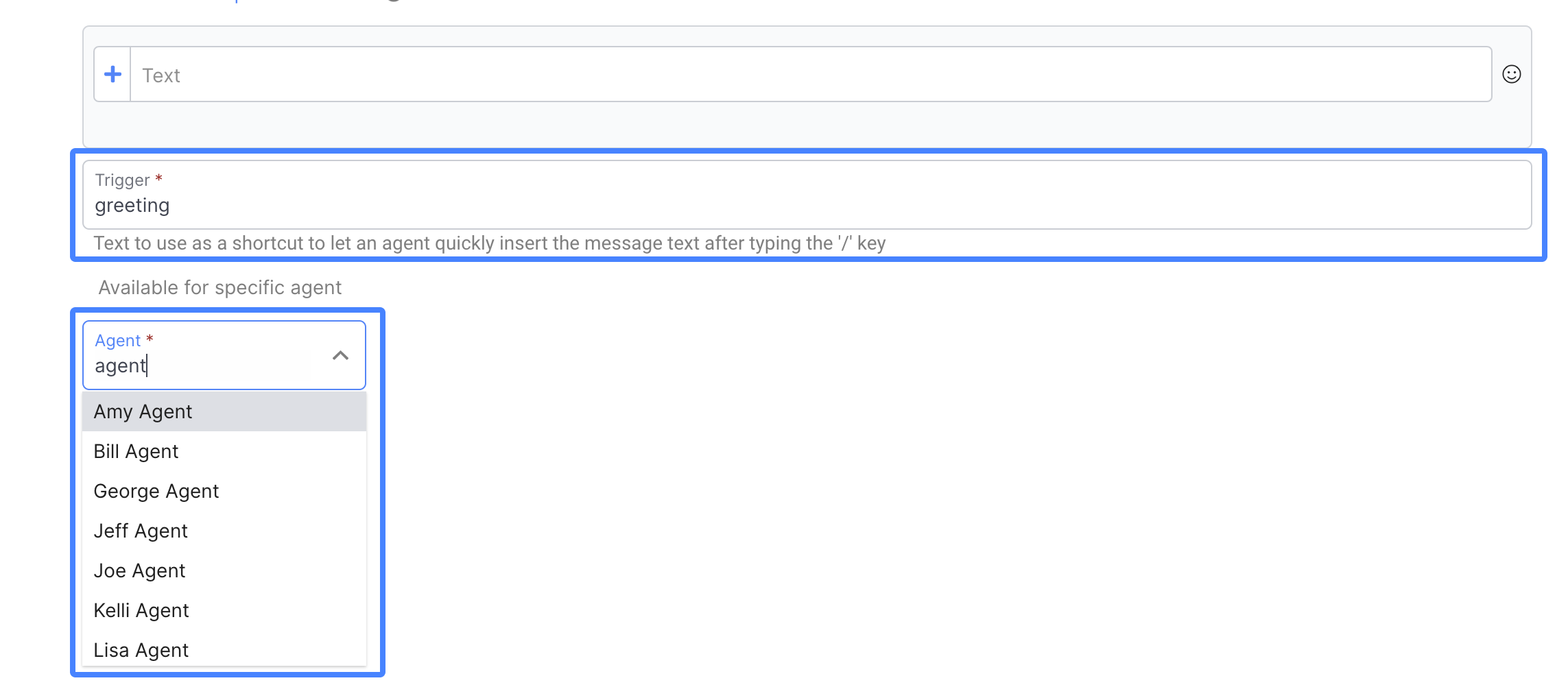
Available for specific bot
When Available for a specific bot is selected, you'll need to select the Bot who has access to this Message.

Hide Message in Agent Transcript
Use the Hide message in agent transcripts checkbox when you're sending potentially sensitive information you want your customers to see, but don't want any users in Quiq to see. When this is enabled , Agents, Managers, Staff Admins, and Admins will see whatever text you define in the Transcript Override Text field, but not the actual message sent to your users:

This feature hides the message from all Quiq users in all locations (including CSV exports, CRM transcripts, and all Quiq analytics.
Message Variables & Placeholders
Depending on where a Catalog Message will be used, Message Variables can be inserted within the message text in spots that you want to be replaced with dynamic, personalized text at the time of sending. This allows you to create a generic template for a Message that contains places that can be filled in either automatically at runtime, or manually by the agent before the message is sent.
In scenarios where a human agent is crafting a message, you may want to give them more agency in populating parts of the message content. Message Placeholders are a way to configure a message so that agents will have a template that contains spots that they may need to fill out manually at the time they are authoring the message. Placeholders display as an editable UI input form directly within the message text to draw the agent’s attention and assist in filling everything out before sending the message.
When adding a Message Variable to a Catalog Message, a checkbox is available that can be used to set the Variable as a placeholder.
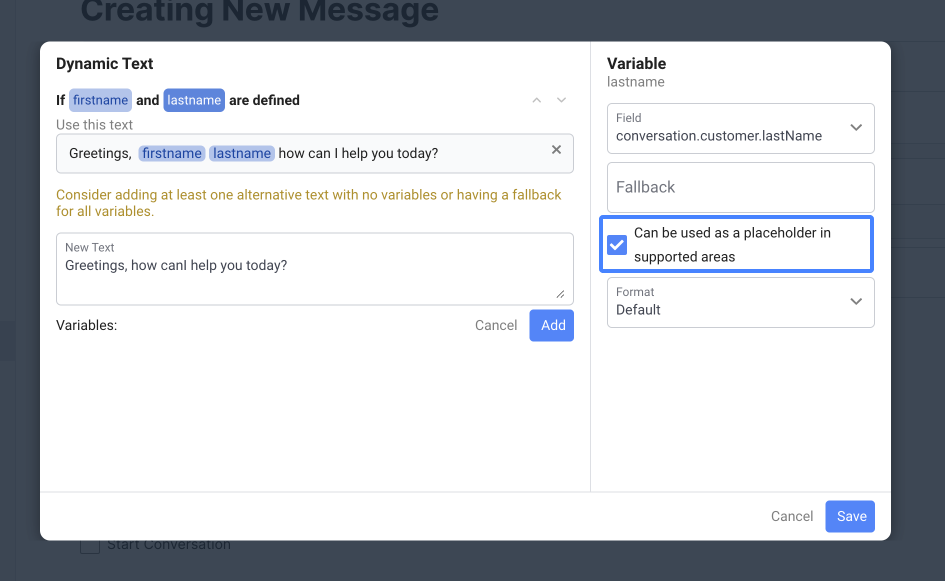
If a Message Variable is set to be a placeholder, that setting will override the Fallback or Alternative Text set for the variable at runtime.
A Message Variable set as a placeholder can be associated with a Field, in which case it will only need to be manually populated by the agent if that field doesn't have a value when the Snippet is selected. Note that the fields available in the Field menu depend on the Availability set for the Catalog Message. For example, Bot Session Fields are only available when the Availability is set to Available for specific bot, and if the specific Bot associated with that Catalog Message has Bot Session Fields defined.
Placeholders can also be defined without an associated Field, which means that the placeholder will always need to be filled in by the agent. This type of placeholder may be useful if your organization makes use of Snippets that contain spots in the message's text content that always need to be filled in by your agents before the message is sent to the customer - adding a placeholder to those locations in the Snippet's text will allow the agent to more easily see where that content needs to be set.
Placeholder Locations
A Message Variable can only be used as a placeholder in locations where agents can intervene prior to the message being sent, such as when the Catalog Message is selected as a Snippet in an active conversation, Outbound Notification or the Start Conversation dialog. If a variable has been set as a placeholder but is used in an automation flow such as in a Bot message, it's recommended that a valid Fallback or Alternative Text be defined for the variable.
Also keep in mind that if a Message Variable defined in the rich content of a Catalog Message is set as a placeholder, for example in a Card Title, the placeholder might not be accessible to the agent in some locations. In those cases, if a message is sent that contains a variable set as a placeholder that isn't filled in by an agent, the literal placeholder string may be sent to the customer (i.e. What can we help you with today {{ph_first}}). To avoid this scenario, it's recommended that in most cases placeholders are only used in the text content of a Catalog Message.
When a Catalog Message with placeholders is selected as a Snippet in an active conversation, the Start Conversation dialog, or in an Outbound Notification, and the variable doesn't have a value, the placeholder input form displays in an invalid state, marked by a yellow background color. The placeholder UI allows the agent to click inside the input form and enter their desired text. It is also possible to use the TAB key to move between multiple placeholders in a message quickly. When the agent begins filling in a placeholder, the validation state changes the background color from yellow to blue.

If the agent tries to send a message with empty placeholders, the Send action is prevented and a warning message is displayed. This prevents the customer from receiving an incomplete message. Placeholders can also be deleted from the message as needed. When all placeholders are successfully filled in, the message can be sent.

If the fields associated with the variable already have a value, the message will appear with the placeholders already filled out:

Creating Catalog Messages Inline
New Catalog Messages can be created inline from Proactive AI, Bots & Conversation Rules by leveraging the + button that appears next to the Catalog Message dropdown, in Send a catalog message Actions in Conversation Rules and the Bot Designer, and Show message blurb Actions in Proactive AI.

When creating Catalog Messages inline, the options available in the Availability section depend on the location. In Proactive AI, only the Available in specific areas & Available everywhere options are available. By default, Proactive AI in Available in specific areas is selected when creating a Catalog Message in this location. Proactive AI can't be deselected while the Available in specific areas option is selected, since the Catalog Message must be available in the area it's being used in.
In the Bot Designer, Available in specific areas, Available everywhere, Available for all bots & Available for this specific bot options are available. By default, Available for this specific bot is selected when creating a Catalog Message in this location.
In Conversation Rules, the Available in specific areas & Available everywhere options are available. By default, Conversation Rules in Available in specific areas is selected when creating a Catalog Message in this location. Conversation Rules can't be deselected while the Available in specific areas option is selected, since the Catalog Message must be available in the area it's being used in.
Also note that when creating or updating a Catalog Message inline, the rich messaging elements available in the + button's menu that can be added to the Message may differ slightly depending on the location.
Using Catalog Messages
Agent Conversations
Agents can use Catalog Messages that have been shared with them as a Snippet, by using the "/" Trigger that has been defined in the Message Catalog, or by just selecting the Message from the Snippets list:
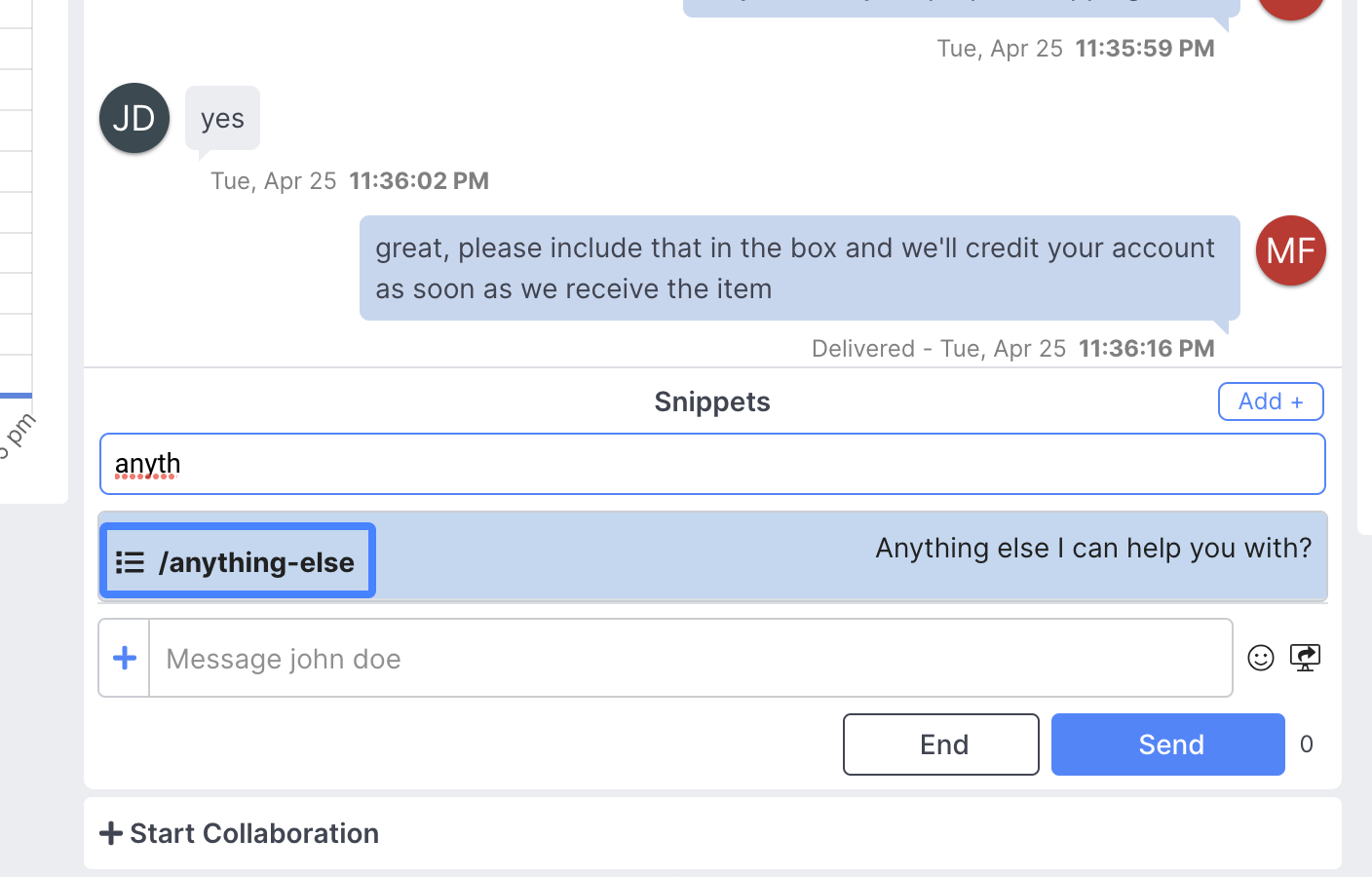
Conversation Rules
Catalog Messages can be used in Conversation Rules by selecting Add action step, then selecting Send catalog message:

Outbound Notifications
Catalog Messages can be added to an Outbound Notification by using the Snippet option under the + button:
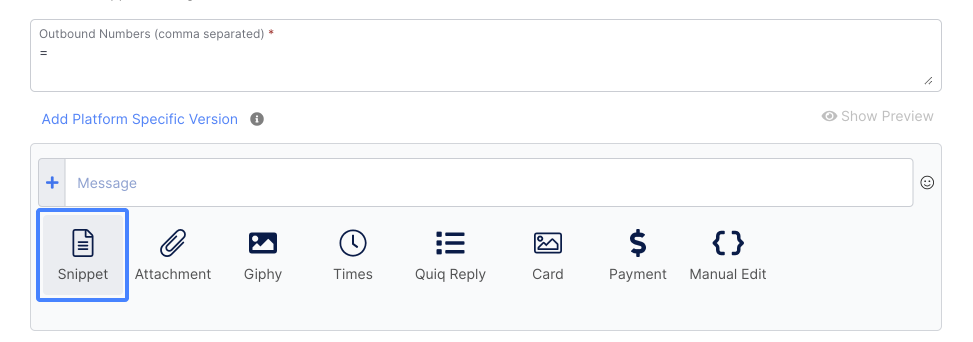
Proactive AI
Catalog Messages can be used in Proactive AI by selecting Add action step, then selecting Show message blurb:
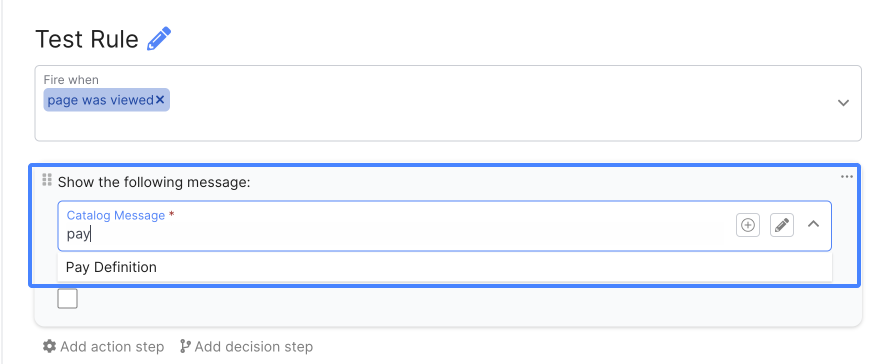
Start Conversation
Catalog Messages can be used when starting a conversation by using the Snippet button in the initiate conversation screen:

Updated about 2 months ago
